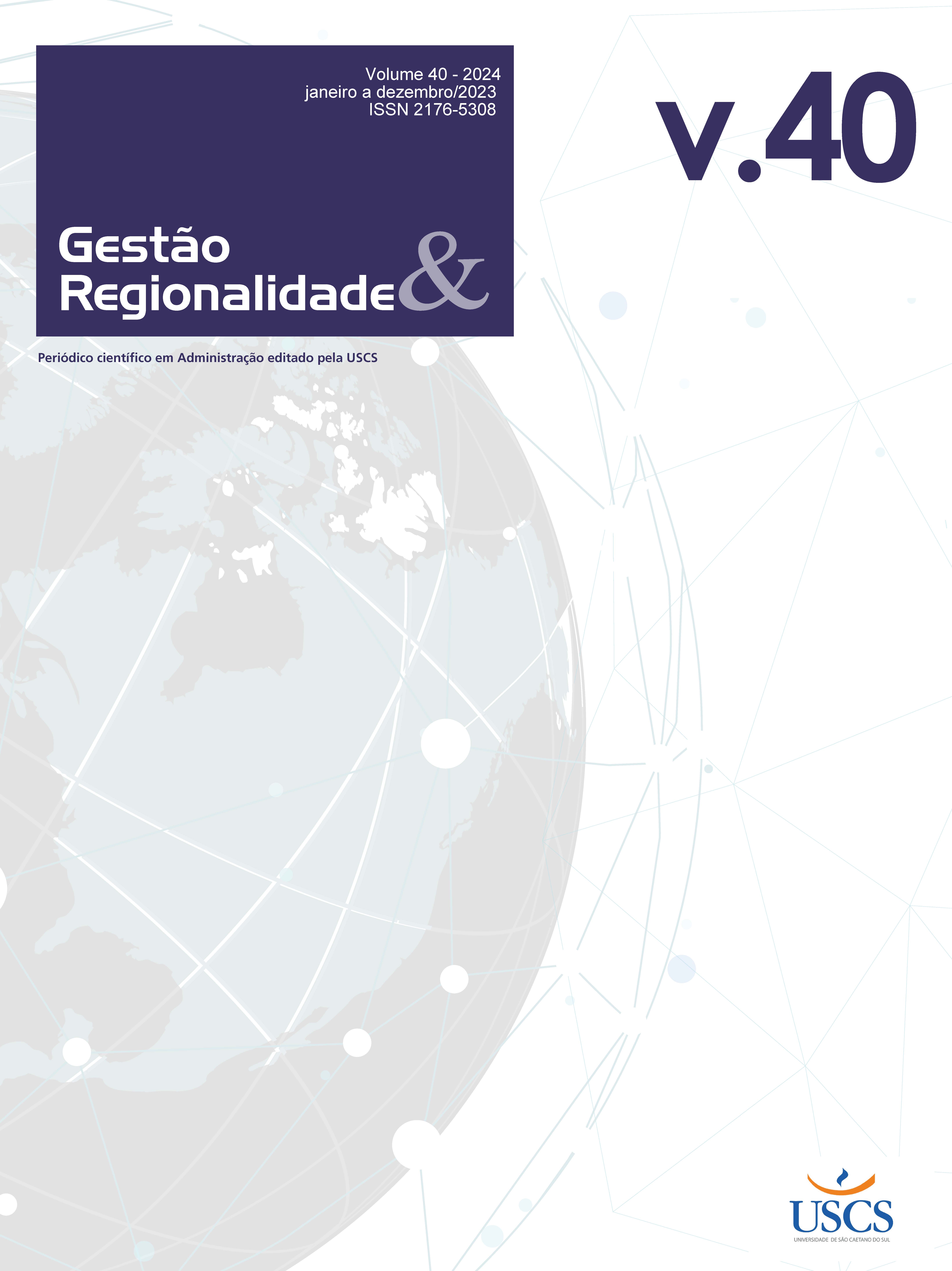The dynamics of industrial employment in Mato Grosso do Sul (2009-2019)
DOI:
https://doi.org/10.13037/gr.vol40.e20248347Keywords:
Industrial Economics, Annual List of Social Information, Location Quotient, Redistribution Coefficient, Location CoefficientAbstract
The purpose of this article is to analyze the concentration of industrial employment in Mato Grosso do Sul between 2009-2019. In specific and methodological terms, the Location Quotient (QL), Redistribution Coefficient (CR), Location Coefficient (CL) and Relative Employment Participation (PR) of the industrial sector in Mato Grosso do Sul in the period 2009-2019 were used, with in order to analyze the dynamics of that segment. Among other reasons, the present work is justified by the lack of publications using the mentioned methods, to the industrial sector and to the state of Mato Grosso do Sul, updated for the period 2009-2019. Furthermore, in addition to being one of the UN's sustainable development goals (ninth), the industrial segment represents a significant production chain, capable of generating employment and income. The results found show that the region of Pantanal, Bodoquena and Aquidauana remain as the most prominent in mineral extraction, unlike the transformation industry that has greater sprawl in the state.
Downloads
References
Bernardo, L. V. M., & Farinha, M. J. U. S. (2019). Análise do emprego turístico de Mato Grosso do Sul com o uso de medidas locacionais-2006 a 2013. Interações (Campo Grande), 20, 679-690. DOI: https://doi.org/10.20435/inter.v0i0.1879
Cruz, B. D. O., & Santos, I. R. S. D. (2011). Dinâmica do emprego industrial no Brasil entre 1990 e 2009: uma visão regional da desindustrialização.
Dalle Tese, Diogo; Mattei, Taíse Fátima. Medidas de localização e especialização para as mesorregiões de Santa Catarina. Revista Brasileira de Desenvolvimento Regional, v. 7, n. 2, p. 195-220, 2020. DOI: https://doi.org/10.7867/2317-5443.2019v7n2p195-220
Fochezatto, A. (2010). Desenvolvimento regional: recomendações para um novo paradigma produtivo. Três décadas de economia gaúcha. O ambiente regional.
Furtado, C. (2020). Formação econômica do Brasil. Companhia das Letras.
Gomes, T. N. (2016). A dimensão espacial do processo de reestruturação da indústria no Mato Grosso do Sul de 2000 a 2014.
Haddad, P. R., Ferreira, C. D. C., Boisier, S., & ANDRADE, T. A. (1989). Economia regional: teorias e métodos de análise (pp. 225-248). Fortaleza: BNB/ETENE.
Mattei, T. F., & Mattei, T. S. (2017). Métodos de Análise Regional: um estudo de localização e especialização para a Região Sul do Brasil. Revista Paranaense de Desenvolvimento, 38(133), 227-243.
Medeiros, M. Z. D. (2014). Desenvolvimento regional da microrregião de Criciúma: um estudo sobre o desenvolvimento industrial.
Mello, J. M. C. (1998). O capitalismo tardio. São Paulo: Brasiliense, 1998.
Mesquita, F. N. (2014). Políticas públicas, produção de celulose e dinâmica territorial: o caso da microrregião de Três Lagoas, Mato Grosso do Sul.
Ministério da Economia. Relação Anual de Informações Sociais – RAIS. Disponível em: <https://bi.mte.gov.br/bgcaged/rais.php>. Acesso em: 19 out. 2021.
ONU, Organizações das Nações Unidas. Objetivos de desenvolvimento sustentável. Disponível em: https://odsbrasil.gov.br/. Acesso em: 29 out. 2021.
Paz, P. P., & Lamberti, E. (2020). A lógica industrial de Mato Grosso do Sul: algumas reflexões a partir dos incentivos fiscais. ENTRE-LUGAR, 11(22), 169-196. DOI: https://doi.org/10.30612/el.v11i22.11241
Pereira, R. C. O., & Gomes, C. A. (2004). O recente processo de industrialização de Três Lagoas-MS. Econ. Pesqui., Araçatuba, 6, 50-65.
Santos, K. F., & Missio, F. J. (2021). Políticas Públicas de desenvolvimento regional em Mato Grosso do Sul. Nova Economia, 30, 921-950. DOI: https://doi.org/10.1590/0103-6351/5248
Serra, J. (1982). Ciclos e mudanças estruturais na economia brasileira de após-guerra. Brazilian Journal of Political Economy, 2(2).
Silva, J. C. M. da, & da Silva Filho, L. A. (2017). Panorama da Indústria nas Macrorregiões Brasileiras: Análise a Partir de Medidas Regionais e de Localização. Revista portuguesa de estudos regionais, (45), 27-47. DOI: https://doi.org/10.59072/rper.vi45.471
Tavares, M. D. C. (1972). Da substituição de importações ao capitalismo financeiro: ensaios sobre economia brasileira. Biblioteca de ciências sociais. Economia Biblioteca de ciências socias (Zahar Editores).
Zamberlan, C. O., Nogueról, L. P. F., Sonaglio, C. M., & Zamberlan, J. F. (2010). Análise da industrialização sul-mato-grossense em face da industrialização brasileira. Revista Brasileira de Gestão e Desenvolvimento Regional, 6 (3)
Published
How to Cite
Issue
Section
License
Copyright (c) 2024 Odirlei Fernando Dal Moro, Moisés Centenaro, Rosele Marques Vieira, Alesandro Ramos da Silva (Autor)

This work is licensed under a Creative Commons Attribution-NonCommercial-NoDerivatives 4.0 International License.
Autores que publicam nesta revista concordam com os seguintes termos:
- Autores mantém os direitos autorais e concedem à revista o direito de primeira publicação, com o trabalho simultaneamente licenciado sob a https://creativecommons.org/
licenses/by-nc-nd/4.0/ , permitindo o compartilhamento do trabalho com reconhecimento da autoria do trabalho e publicação inicial nesta revista. - Autores têm autorização para assumir contratos adicionais separadamente, para distribuição não-exclusiva da versão do trabalho publicada nesta revista (ex.: publicar em repositório institucional ou como capítulo de livro), com reconhecimento de autoria e publicação inicial nesta revista.
- Autores têm permissão e são estimulados a publicar e distribuir seu trabalho online (ex.: em repositórios institucionais ou na sua página pessoal) a qualquer ponto antes ou durante o processo editorial, já que isso pode gerar alterações produtivas, bem como aumentar o impacto e a citação do trabalho publicado (Veja O Efeito do Acesso Livre).
























